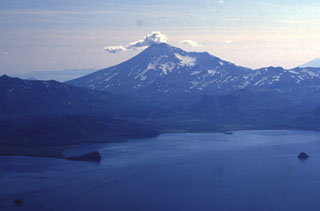Report on Kambalny (Russia) — 22 March-28 March 2017
Smithsonian Institution / US Geological Survey
Weekly Volcanic Activity Report, 22 March-28 March 2017
Managing Editor: Sally Sennert.
Please cite this report as:
Global Volcanism Program, 2017. Report on Kambalny (Russia) (Sennert, S, ed.). Weekly Volcanic Activity Report, 22 March-28 March 2017. Smithsonian Institution and US Geological Survey.
Kambalny
Russia
51.306°N, 156.875°E; summit elev. 2116 m
All times are local (unless otherwise noted)
KVERT reported that the onset of an eruption at Kambalny, witnessed by staff at the Kronotsky State Nature Reserve, began at 0950 on 25 March. Satellite data showed an ash plume drifting 35 km SW at altitudes of 5-6 km (16,400-19,700 ft) a.s.l. The Aviation Color Code was raised to Orange (the second highest level on a four-color scale). The eruption intensified later that day, with ash plumes rising as high as 7 km (23,000 ft) a.s.l. and drifting as far as 255 km SSW. Ash plumes continued to be generated at least through 28 March, varying in altitude from 3.5-6 km (11,500-19,700 ft) a.s.l. and drifting as far as 1,350 km SSW, S, SSE, and SE during 26-27 March, and 51 km W on 28 March.
Geological Summary. The southernmost major stratovolcano on the Kamchatka peninsula, Kambalny has a summit crater that is breached to the SE. Five Holocene cinder cones on the W and SE flanks have produced fresh-looking lava flows. Beginning about 6,300 radiocarbon years ago, a series of major collapses of the edifice produced at least three debris-avalanche deposits. The last major eruption took place about 600 years ago, although younger tephra layers have been found, and an eruption was reported in 1767. Active fumarolic areas are found on the flanks of the volcano, which is located south of the massive Pauzhetka volcano-tectonic depression.
Sources: Kamchatkan Volcanic Eruption Response Team (KVERT), Kronotsky State Nature Reserve

